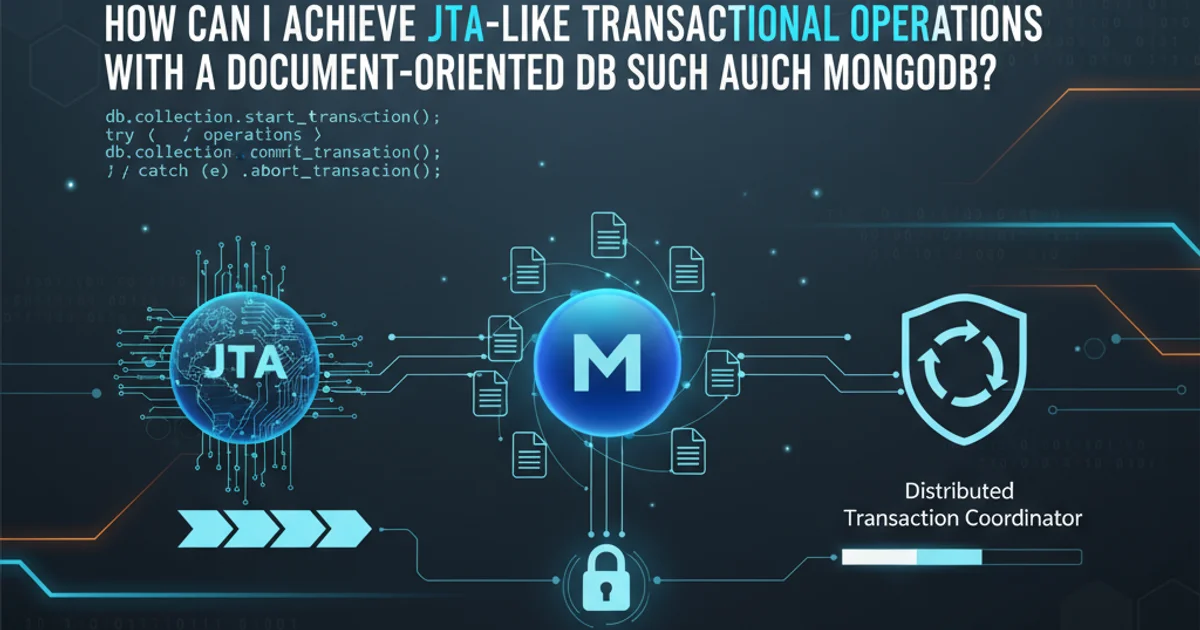How can I achieve JTA-like transactional operations with a document-oriented DB such as MongoDB?
Achieving JTA-like Transactions in Document Databases like MongoDB

Explore strategies and patterns for implementing robust, multi-document transactional operations in MongoDB, mimicking the behavior of Java Transaction API (JTA) in a NoSQL environment.
Traditional relational databases offer ACID (Atomicity, Consistency, Isolation, Durability) properties, often managed through mechanisms like JTA for distributed transactions. Document-oriented databases like MongoDB, while offering high scalability and flexibility, historically approached transactions differently. However, with the introduction of multi-document ACID transactions in MongoDB 4.0+, it's now possible to achieve JTA-like transactional operations, albeit with different patterns and considerations. This article delves into how to design and implement such transactional behavior in MongoDB.
Understanding MongoDB's Transactional Capabilities
Before MongoDB 4.0, atomicity was guaranteed at the single-document level. Operations modifying a single document were atomic. For multi-document operations, developers often relied on patterns like two-phase commit (2PC) or application-level retries to ensure data consistency. MongoDB 4.0 introduced multi-document ACID transactions across replica sets, and MongoDB 4.2 extended this to sharded clusters. These transactions provide the familiar ACID guarantees for operations spanning multiple documents and collections within a single replica set or across a sharded cluster.
flowchart TD
A[Application Request] --> B{Start Transaction}
B --> C[Operation 1: Modify Document A]
C --> D[Operation 2: Modify Document B]
D --> E{All Operations Successful?}
E -->|Yes| F[Commit Transaction]
E -->|No| G[Abort Transaction]
F --> H[Transaction Complete]
G --> HBasic flow of a multi-document transaction in MongoDB
Implementing Transactions with MongoDB Drivers
Modern MongoDB drivers provide APIs to manage sessions and transactions. The general pattern involves starting a client session, initiating a transaction within that session, performing your read/write operations, and then committing or aborting the transaction. It's crucial to include retry logic for transient transaction errors, as transactions can occasionally fail due to network issues, write conflicts, or primary elections.
import com.mongodb.client.ClientSession;
import com.mongodb.client.MongoClient;
import com.mongodb.client.MongoClients;
import com.mongodb.client.MongoCollection;
import com.mongodb.client.TransactionBody;
import org.bson.Document;
public class MongoTransactionExample {
public static void main(String[] args) {
try (MongoClient mongoClient = MongoClients.create("mongodb://localhost:27017")) {
MongoCollection<Document> accounts = mongoClient.getDatabase("bank").getCollection("accounts");
// Start a client session
try (ClientSession clientSession = mongoClient.startSession()) {
TransactionBody<String> txnBody = () -> {
// Debit from account A
accounts.updateOne(clientSession, new Document("_id", "accountA"), new Document("$inc", new Document("balance", -100)));
// Credit to account B
accounts.updateOne(clientSession, new Document("_id", "accountB"), new Document("$inc", new Document("balance", 100)));
return "Transaction committed";
};
try {
// Execute the transaction with retry logic
System.out.println(clientSession.withTransaction(txnBody));
} catch (Exception e) {
System.err.println("Transaction aborted: " + e.getMessage());
// Handle specific transaction errors, e.g., transient errors
}
}
}
}
}
Java example demonstrating a multi-document transaction for a bank transfer.
ClientSession and use withTransaction or explicit startTransaction/commitTransaction/abortTransaction calls. Implement robust retry logic for transient errors, especially MongoTransientTransactionError.Considerations for JTA-like Behavior and Distributed Transactions
While MongoDB's transactions provide ACID guarantees, they are not directly equivalent to JTA's distributed transaction management across heterogeneous systems. JTA coordinates transactions across multiple resource managers (e.g., different databases, message queues). MongoDB transactions are confined to a single MongoDB deployment (replica set or sharded cluster). If your application requires transactions spanning MongoDB and other systems (e.g., a relational database, a message broker), you'll need to implement a higher-level coordination mechanism, such as the Saga pattern or a custom two-phase commit at the application level.
flowchart LR
A[Application Service] --> B{Start Local Transaction (MongoDB)}
B --> C[Update MongoDB Docs]
C --> D{Publish Event (Kafka/RabbitMQ)}
D --> E{Commit Local Transaction}
E --> F[Other Service Consumes Event]
F --> G[Perform Action in Other DB]
G --> H{Acknowledge/Compensate}
subgraph Saga Pattern
B -- "Local Transaction" --> E
D -- "Event-Driven" --> F
endIllustrating the Saga pattern for distributed transactions across MongoDB and other services.